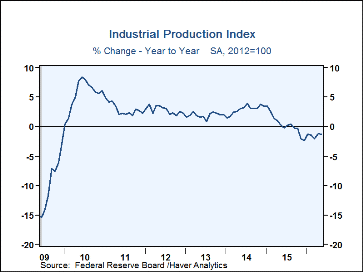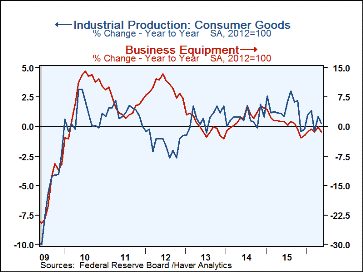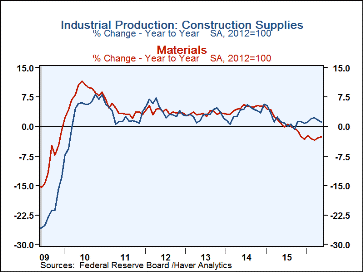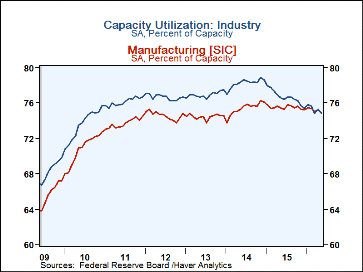 Global| Jun 15 2016
Global| Jun 15 2016U.S. Industrial Production Declines Unexpectedly
by:Tom Moeller
|in:Economy in Brief
Summary
Industrial output fell 0.4% during May (-1.4% y/y) following a 0.6% rise, revised from 0.7%. It was the third decline this year and left output 0.2% below December. No change in output had been expected in the Action Economics [...]
Industrial output fell 0.4% during May (-1.4% y/y) following a 0.6% rise, revised from 0.7%. It was the third decline this year and left output 0.2% below December. No change in output had been expected in the Action Economics Forecast Survey.
Factory sector production declined 0.4% last month (-0.1% y/y) following a 0.2% rise, revised from 0.3%. Consumer goods production fell 0.7% (+0.3% y/y) as motor vehicle output & parts output declined 4.2% (-1.4% y/y) after a 1.6% rise. Machinery output fell 1.1% (-4.2% y/y) and furniture production was off 0.8% (+1.0% y/y), the fourth consecutive monthly drop. These declines were offset by a 0.6% rise (3.8% y/y) in computer & electronic component production and a 0.6% increase (-0.7% y/y) in primary metals output.
In the nondurable goods sector, chemical output rose 0.4% (1.1% y/y) while paper product production also improved 0.4% (-3.4% y/y). Offsetting these gains, apparel output declined 0.9% (-9.4% y/y) and petroleum & coal production fell 0.7% (+0.8% y/y).
A 1.0% decline in utility output (-0.8% y/y) added to last month's weakness in total production. Electric power generation fell 1.6% (-1.0% y/y), but natural gas production rose 4.7% (0.4% y/y). Mining sector production gained 0.2% (-11.6% y/y), the first increase in nine months.
In the subcategory groupings, output of high technology products improved 0.5% (2.4% y/y) as computer & office equipment production jumped 2.4% (0.2% y/y). Communications equipment eased 0.3% (+9.9% y/y). Overall factory sector production excluding the high-tech & motor vehicle sectors eased 0.1% (-0.2% y/y), down for the third month this year.
Capacity utilization declined to 74.9% from 75.3%, revised from 75.4%. That remained lower than 78.9% in November 2014. Factory sector utilization fell to 74.8%, and was down from the 2014 high of 76.3%. Industry capacity rose 0.8% y/y while factory sector capacity also improved 0.8% y/y.
Industrial production and capacity data are included in Haver's USECON database, with additional detail in the IP database. The expectations figure is in the AS1REPNA database.
| Industrial Production (SA, % Change) | May | Apr | Mar | May Y/Y | 2015 | 2014 | 2013 |
|---|---|---|---|---|---|---|---|
| Total Output | -0.4 | 0.6 | -1.0 | -1.4 | 0.3 | 2.9 | 1.9 |
| Manufacturing | -0.4 | 0.2 | -0.4 | -0.1 | 0.8 | 1.3 | 0.9 |
| Consumer Goods | -0.7 | 1.1 | -1.2 | 0.3 | 1.4 | 0.7 | 0.7 |
| Business Equipment | -0.7 | 1.2 | -0.5 | -1.4 | 0.7 | 2.4 | -0.2 |
| Construction Supplies | -0.3 | 0.2 | -0.8 | 1.2 | 1.5 | 3.7 | 3.0 |
| Materials | -0.2 | 0.2 | -0.9 | -2.7 | 0.5 | 4.7 | 3.3 |
| Utilities | -1.0 | 6.1 | -3.9 | -0.8 | -0.7 | 1.3 | 2.3 |
| Mining | 0.2 | -2.6 | -2.4 | -11.5 | -1.8 | 11.0 | 6.5 |
| Capacity Utilization (%) | 74.9 | 75.3 | 74.8 | 76.6 | 76.7 | 78.2 | 76.9 |
| Manufacturing | 74.8 | 75.2 | 75.1 | 75.5 | 75.5 | 75.4 | 74.5 |
Tom Moeller
AuthorMore in Author Profile »Prior to joining Haver Analytics in 2000, Mr. Moeller worked as the Economist at Chancellor Capital Management from 1985 to 1999. There, he developed comprehensive economic forecasts and interpreted economic data for equity and fixed income portfolio managers. Also at Chancellor, Mr. Moeller worked as an equity analyst and was responsible for researching and rating companies in the economically sensitive automobile and housing industries for investment in Chancellor’s equity portfolio. Prior to joining Chancellor, Mr. Moeller was an Economist at Citibank from 1979 to 1984. He also analyzed pricing behavior in the metals industry for the Council on Wage and Price Stability in Washington, D.C. In 1999, Mr. Moeller received the award for most accurate forecast from the Forecasters' Club of New York. From 1990 to 1992 he was President of the New York Association for Business Economists. Mr. Moeller earned an M.B.A. in Finance from Fordham University, where he graduated in 1987. He holds a Bachelor of Arts in Economics from George Washington University.










